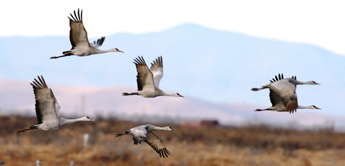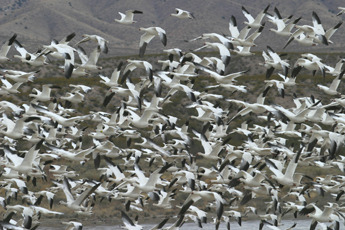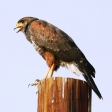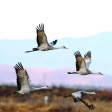Rare arctic and desert species New Mexico, 10 birding days
New Mexico is a large state blessed with a varied landscape of arid deserts, lush forests, soaring mountain ranges and rolling plains. Thus it offers a fantastic sunny winter birding with a wide range of different habitats and species. Imagine looking for tens of thousands of Ross’s and Snow Geese, Sandhill Cranes and Verdin, Phainopepla and Pyrrhuloxia at the same time! We visit the best parts of New Mexico from the wild and rich Rio Grande Valley through deserts, scrubs and cottonwoods. Add the extensive mountain pinewoods plus unbelievable spectacle of wetland areas such as the world famous Bosque del Apache and you have a really enjoyable “cocktail of winter birding” in the US.
{backbutton}
Fact File
- 10 days in New Mexico, USA
- start and finish in Albuquerque
- using 2 accommodations located close to the sites
Highlights
- 5 days in the Rio Grande Valley and surrounding hills
- 5 days in the Bosque del Apache National Wildlife Refuge and at nearby lakes
- wide variety of wintering and resident birds
- tens of thousands of geese and cranes plus other interesting bird species
Price
Ask for the actual price.
Our price includes:
- all travel as noted in the itinerary;
- all accommodation based on shared rooms (most rooms are twin bedded), at most locations there are single rooms as well for extra charge (Please ask for a single room at the time of booking!);
- 3 meals per day, generally breakfast at the accommodation, packed lunch, dinner (consists of at least two courses);
- services of the leader(s);
- trip materials.
Not included:
- flights to and from Albuquerque
- optional programmes to places of interest and entrance fees involved;
- airport and other departure taxes, tips;
- food beyond generally 3 meals/day mentioned in the itineraries;
- excess baggage charges;
- telephone calls;
- alcoholic beverages;
- compulsory personal insurance.
If you have questions about the inclusion of any cost item, please contact us.
Activity level
- Generally easy to moderate walks
- Lots of onsite wildlife observing possibilities
- Weather generally favourable
Itinerary
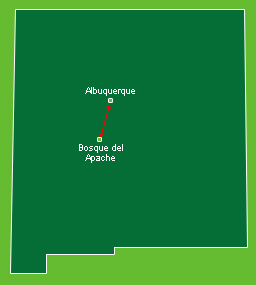
1-4
We arrive to Albuquerque where we will be based to explore the Rio Grande valley and the hilly regions around it.
The Rio Grande Nature Center is a great place to start to get to know the different habitats and its birds. The scrub and cottonwood area and a pond surrounded by reedbeds offers the possibility to see some quite nice array of attractive birds such as Wood Duck, American Wigeon, Gadwall, Ring-necked Duck, Green-winged Teal and Lesser Scaup. Sometimes we can find Goosander, plus Spotted Sandpiper alongside the shore. Usually this is the area where we firat encounter a good number of Sandhill Cranes quite upclose, but the real spectacular fly-out we will witness later on during the tour.
Around the Nature Center and alongside the Rio Grande at the wooded areas we can easily find different forms of Dark-eyed Junco ('Oregon' and 'Pink-sided'), Black-capped Chickadee, Black Phoebe. Woodpeckers will be represented by Northern Flicker and Downy Woodpecker, but White-breasted Nuthatch should search for food at the same trees. We should find White-crowned Sparrow and Spotted Towhee as well.
One of the afternoons or mornings we can spend with checking out some good birding areas close to Albuquerque where there is a chance for Curve-billed and Crissal Thrashers, Lesser Goldfinch, Gambel's Quail and many more.
On another day when weather will be really promising without any wind we will make a discovery tour up to the Sandia Hill's peak. The hill is towering over the desert area, dominating the landscape with its crest over 10600 feet. One of the reasons why we try here high elevation birding is to have a chance to see the different species and forms of the Rosefinches. If we are lucky than we will see all 4, Brown-capped, Black, Grey-crowned Rosefinches -including Hepburn's Grey-crowned.
We can watch these lovely birds through clear windows of a cafe. It is always worth to look around alongside the nearby trails as well, plus it is a perfect raptor „look-down" J point.
As we go down we might stop at a few lower elevation trails and check out foothill species on the south side of the Sandia Hill.
Common Raven is quite regular, good chance for Steller's Jay and Mountain Chickadee. This is an area where both White-breasted and Red-breasted Nuthatches are regularly seen, alongside with different forms of Dark-eyed Junco.
Also on the way down we can see Hairy Woodpecker and Northern Flicker, or flocks of Red Crossbill. It is much harder to find Townsend's Solitaire now without hearing its remarkable, metallic flute.
Depending on how birding went on the previous days we might venture a bit North and North East of Albuquerque. Santa Fe Ski Basin area has some nice forest trails where we can look for Clark's Nutcrackers, Steller's Jay, Mountain Chickadee and Canyon Towhee. This area gives us another chance to find Hairy Woodpecker, Townsend Solitaire and Mountain Bluebird among many others.
Further at North-East corner of New Mexico we can visit Las Vegas National Wildlife Refuge and Conchas Lake.
Here we can surely find Sandhill Crane, Snow and Canada Goose, Mallard, Gadwall, Bufflehead and American Coot. Also good number of Horned Lark wintering in the area.
Quite common to see at the water Ross's Goose, Northern Pintail, Northern Shoveler, Lesser Scaup, Common Goldeneye, Ruddy Duck and Common Snipe. The most common raptor species here include Bald Eagle, Northern Harrier, Golden Eagle, American Kestrel and even Prairie Falcon. Jays and crows usually represented by Black-billed Magpie, American Crow and Common Raven. Mountain Bluebird oftenly seen and on the ground and among the bushes we should find Canyon Towhee, American Tree Sparrow, White-crowned Sparrow, Dark-eyed Junco and its kins, "Oregon Junco", "Pink-sided Junco" and "Grey-headed Junco".
Red-winged Blackbird, Western Meadowlark, House Sparrow and Eurasian Starling is everywhere.
The following species are always present, but not certain to be seen partly because some of them are real challenge to spot, others are simply uncommon:
Pied-billed Grebe, American Bittern, Great Blue Heron, Greater White-fronted Goose, American Wigeon, Ring-necked Duck, Belted Kingfisher, Cooper's Hawk, Red-tailed Hawk, Ferruginous Hawk, Rough-legged Hawk, Merlin, Scaled Quail, Killdeer, Ring-billed Gull, Barn Owl, Western Screech-Owl, Great Horned Owl, Ladder-backed Woodpecker, Downy Woodpecker, Hairy Woodpecker, Northern Flicker, Black-capped Chickadee, Mountain Chickadee, White-breasted Nuthatch, Pygmy Nuthatch, Brown Creeper, Canyon Wren, Bewick's Wren, Townsend's Solitaire, American Robin, Northern Mockingbird, Rufous-sided Towhee, Chipping Sparrow, House Finch, Pine Siskin, American Goldfinch.
Beside the above mentioned species occasionally we can find on the water Cinnamon Teal, Canvasback, Redhead, Hooded and Common Merganser. There is a much smaller chance for Sharp-shinned Hawk here than Cooper's and sometimes we see Greater Roadrunner as well. Depending on the Winter and fluctuation of prey we might have a chance for Long and Short-eared Owls as well. The beautiful Lewis' Woodpecker is always a great surprise and we have a chance for Williamson's Sapsucker as well.
Other occasionally present species are Steller's Jay, Western Scrub-Jay, Chihuahuan Raven, Plain Titmouse, Bushtit, Red-breasted Nuthatch, Rock Wren, Golden-crowned Kinglet, Ruby-crowned Kinglet, Western Bluebird, Cedar Waxwing, Northern Shrike, Loggerhead Shrike, "Slate-colored Junco", "White-winged Junco", Chestnut-collared Longspur, Brewer's Blackbird, Gray-crowned Rosy Finch, Cassin's Finch and Evening Grosbeak.
5-8
We travel South to the world famous Bosque del Apache National Wildlife Refuge. It is a superb locality for waterbirds and is among the best places to see the spectacular concentration of Snow Geese and Sandhill Cranes.
During the next couple of mornings we will timing our visit as early as possible to experience one of the Earth great spectacular wildlife events, the fly out of tens of thousands of Snow Geese, mixed with smaller number of Ross's Geese and loads of Sandhill Cranes. Every minute is different as the mist rising and the colour of the first beams of sunshine changes. ad the cacophony of trumpeting cranes and noisy geese – it is truly an unforgatteble experience!
No wonder we will try to witness it as many times as possible.
After the early morning spectaculars we will have breakfast and later on we check out both the Marsh Loop and the Farm Loop of the Wildlife Refuge.
We should find quite a wide variety of waterfowl in good numbers, including Green-winged Teal, Readhead, Bufflehead, Canvasback, Pintail, Lesser Scaup. Beside the above mentioned we expect to see Canada Geese, Goosander and Black-crowned Night Heron as well.
Common and Wilson's Snipe should search at the shallow part of the marshes and it could be frustrating to hear Virginia Rail which is not easy to spot.
Passerines will be represented by Black and Say's Phoebe, Song, Fox, White-crowned and Lincoln's Sparrow, Yellow-headed Blackbird, American Pipit, Marsh Wren, Spotted Towhee. This is a good place to check the different forms of Dark-eyed Juncos - Slate-coloured, Oregon and Pink-sided. Mountain Bluebird, Chestnut-coloured Longspur and possibly even McCown's Longspur can colour the list.
Horned Lark and Gambel's Quail should be relatively easy to find.
Raptors will be represented by Sharp-shinned and Cooper's Hawk and we should check Red-tailed Hawks for Harlan's. There are always some Bald Eagles, sometimes more than half a dozen and we have a good chance to see American Kestrel, Merlin, Northern Harrier, but even Prairie Falcon and Ferruginous Hawk as well.
On one of the days we will visit the Water Canyon West of Socorro. On the way we usually see Pronghorn Antelopes. It is a good are for Band-tailed Pigeon and Greater Roadrunner. A nice variety of Woodpeckers can be found including Ladder-backed and Acorn Woodpeckers, plus Williamson's and Red-naped Sapsucker. Other possible species include Townsend's Solitaire, Juniper Titmouse, Cactus Wren, Western Bluebird, Red Crossbill, Pine Siskin, American and Lesser Goldfinch and Sage Sparrow. We also should find Chihuahuan Raven, Golden-crowned Kinglets, White-breasted Nuthatch, Canyon Towhee and Western Scrub Jay.
Another day we visit Elephant Butte, the largest lake in New Mexico. At the water we can compare and practice distinguishing Western and Clark's Grebes, also should find Ruddy Duck and perhaps Red-breasted Merganser. Green-winged Teal, Readhead, Bufflehead and Great Blue Heron is usually there.
The picnic area just below the dam helds Black-throated Sparrow, Verdin, Say's Phoebe, White-winged Dove, Pyrrhuloxia, Ruby-crowned Kinglet, Cactus Wren and sometimes we can smell and then spot Javelina or Collared Pecari as well! J
The RV camp ground area is good for White-crowned Sparrow, Curve-billed and Crissal Thrashers, Ladder-backed Woodpeckers and Gambel's Quails.
The surrounding desert scrub is an ideal place for Western Meadowlark, Brewer's Blackbird, Greater Roadrunner, Chestnut-coloured Longspur, both Gambel's and Scaled Quail and Northern Mockingbirds. Sometimes we can find Lark Bunting, Vesper and Brewer's Sparrow as well.
We will venture further South to visit Percha Dam and Caballo Lake.if we miss any of the below species after the previous days:
At Percha Dam we can look for Crissal Thrasher, Black and Say's Phoebe, Verdin, Phainopepla, Bewick's Wren, Hammond's Flycatcher, Cedar Waxwing, Western Bluebird
Red-naped Sapsucker, Ladder-backed and Hairy Woodpecker, Cooper's Hawk, Green-winged Teal, Belted Kingfishers, Spotted Towhee, Bridled Titmouse and White-breasted Nuthatch. Sometimes we accidentally flesh an American Bittern as well.
Caballo Dam usually has American Wigeons, Shovelers, Pintails, Western and Clark's Grebes, Olivaceous Cormorants, Ring-billed Gulls and Great Blue Herons, plus Common
Goldeneyes. Int he surrounding area we can search for Chihuahuan Raven, Mountain Bluebird, Eastern and Western Bluebirds, White-breasted Nuthatch, Phainopepla, Gambel's Quails and Scaled Quails.
9
Before we drive northwards to Albuquerque we visit parts of the Bosque del Apache and surrounding area again to say goodbye to the masses of Geese and Cranes, plus to check the area for any of the species we have not found during the previous days.
10
11
Depending on our flight times we may check some additional birding areas in Albuquerque before heading to the airport to catch our flight back home.
Arrival home after an overnight flight.


























